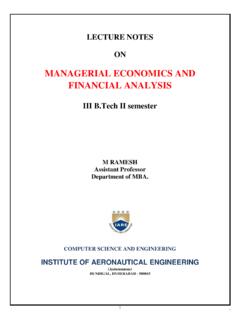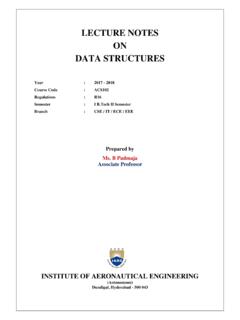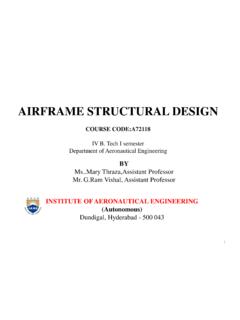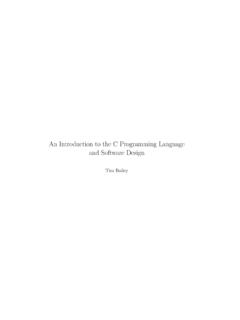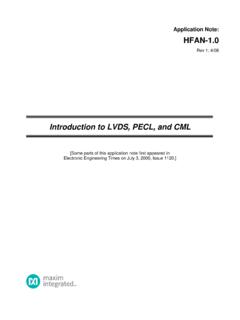Transcription of MICROPROCESSORS AND INTERFACING DEVICES
1 LECTURE NOTES ON MICROPROCESSORS AND INTERFACING DEVICES III B. Tech II semester (JNTUH-R15) Mahendhar Reddy, Associate Professor, ECE ELECTRICAL AND ELECTRONICS ENGINEERING INSTITUTE OF AERONAUTICAL ENGINEERING (AUTONOMOUS) DUNDIGAL, HYDERABAD - 500 043 Syllabus: JAWAHARLAL NEHRU TECHNOLOGICAL UNIVERSITY HYDERABAD L T/ /P/D C III Year ECE -II Sem 4 -/-/- 4 MICROPROCESSORS AND INTERRFACING DEVICES UNIT I 8086 MICROPROCESSOR.
2 8086 architecture- Functional Diagram, Register Organization, Memory segmentation, Memory addresses, physical memory organization, Signal descriptions of 8086-common function signals, Minimum and Maximum mode signals, Read Write cycles, Timing diagrams, Interrupt structure of 8086. UNIT II ASSEMBLY LANGUAGE PROGRAMMING OF 8086: Instruction formats, addressing modes, instruction set, assembler directives, macros, Simple programs involving logical, branch and call instructions, Sorting, evaluating arithmetic expressions, string manipulations.
3 UNIT III PERIPHERAL INTERFACING WITH 8086 MICROPROCESSOR: 8255 PPI, Keyboard, display controllers, Stepper motor, A/D & D/A Converter INTERFACING with 8086 microprocessor. Static and Dynamic memories, Vector interrupt table, Interrupt service routine, introduction to DOS & BIOS interrupts, Programmable Interrupt Controller 8259, DMA controller 8257 INTERFACING with 8086 microprocessor. UNIT IV COMMUNICATION INTERFACE: Serial communication standards, serial data transfer schemes, 8251 USART architecture and INTERFACING , RS-232, IEEE-488, prototyping and trouble shooting.
4 UNIT V introduction TO MICROCONTROLLERS: Overview of 8051 microcontroller, Architecture, I/O ports and Memory organization, addressing modes and instruction set of 8051, Simple programs. UNIT-I 8086 ARCHITECTURE introduction to processor: A processor is the logic circuitry that responds to and processes the basic instructions that drives a computer. The term processor has generally replaced the term central processing unit (CPU).
5 The processor in a personal computer or embedded in small DEVICES is often called a microprocessor. The processor (CPU, for Central Processing Unit) is the computer's brain. It allows the processing of numeric data, meaning information entered in binary form, and the execution of instructions stored in memory. Evolution of Microprocessor: A microprocessor is used as the CPU in a microcomputer. There are now many different MICROPROCESSORS available.
6 Microprocessor is a program-controlled device, which fetches the instructions from memory, decodes and executes the instructions. Most Micro Processor are single- chip DEVICES . Microprocessor is a backbone of computer system. which is called CPU Microprocessor speed depends on the processing speed depends on DATA BUS WIDTH. A common way of categorizing MICROPROCESSORS is by the no. of bits that their ALU can Work with at a time The address bus is unidirectional because the address information is always given by the Micro Processor to address a memory location of an input / output DEVICES .
7 The data bus is Bi-directional because the same bus is used for transfer of data between Micro Processor and memory or input / output DEVICES in both the direction. It has limitations on the size of data. Most Microprocessor does not support floating-point operations. Microprocessor contain ROM chip because it contain instructions to execute data. What is the primary & secondary storage device? - In primary storage device the Storage capacity is limited. It has a volatile memory.
8 In secondary storage device the storage capacity is larger. It is a nonvolatile memory. a) Primary DEVICES are: RAM (Read / Write memory, High Speed, Volatile Memory) / ROM (Read only memory, Low Speed, Non Voliate Memory) b) Secondary DEVICES are: Floppy disc / Hard disk Compiler: Compiler is used to translate the high-level language program into machine code at a time. It doesn t require special instruction to store in a memory, it stores automatically. The Execution time is less compared to Interpreter.
9 Microprocessor: The first microprocessor (Intel 4004) was invented in 1971. It was a 4-bit calculation device with a speed of 108 kHz. Since then, microprocessor power has grown exponentially. So what exactly are these little pieces of silicone that run our computers(" Common Operating Machine Particularly Used For Trade Education And Research ") It has 3200 PMOS transistors. It is a 4-bit device used in calculator. microprocessor: In 1972, Intel came out with the 8008 which is 8-bit.
10 In 1974, Intel announced the 8080 followed by 8085 is a 8-bit processor Because 8085 processor has 8 bit ALU (Arithmetic Logic Review). Similarly 8086 processor has 16 bit ALU. This had a larger instruction set then 8080. used NMOS transistors, so it operated much faster than the 8008. The 8080 is referred to as a Second generation Microprocessor 3. Limitations of 8 Bit microprocessor: Low speed of execution Low memory addressing capability Limited number of general purpose registers Less power full instruction set 4.
